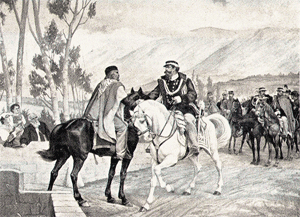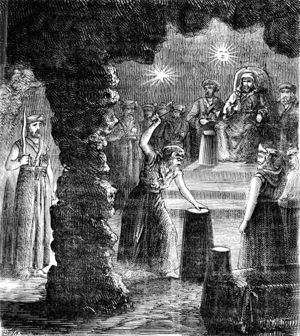Theosophy in Italyby Theosopedia
Accessed: 1/16/19
NOTICE: THIS WORK MAY BE PROTECTED BY COPYRIGHTYOU ARE REQUIRED TO READ
THE COPYRIGHT NOTICE AT THIS LINK BEFORE YOU READ THE FOLLOWING WORK, THAT IS AVAILABLE SOLELY FOR PRIVATE STUDY, SCHOLARSHIP OR RESEARCH PURSUANT TO 17 U.S.C. SECTION 107 AND 108. IN THE EVENT THAT THE LIBRARY DETERMINES THAT UNLAWFUL COPYING OF THIS WORK HAS OCCURRED, THE LIBRARY HAS THE RIGHT TO BLOCK THE I.P. ADDRESS AT WHICH THE UNLAWFUL COPYING APPEARED TO HAVE OCCURRED. THANK YOU FOR RESPECTING THE RIGHTS OF COPYRIGHT OWNERS.
The first contact with Theosophy in Italy may be traced to the frequent presence of H. P. BLAVATSKY there, where she undoubtedly met many persons who later became members of the Theosophical Society. She visited Trieste, Venice, Rome, Bologna, Bari, and Naples.
She is reported to have been with the Italian patriots Giuseppe Garibaldi (1807-82) and Giuseppe Mazzini (1805-72); the latter she apparently met in London in the year 1851. She claimed to have participated with volunteers at Garibaldi’s [1867] battle of Mentana (in an attempt to capture Rome) in the year 1867 (Cranston and Williams, p. 79).
Theosophy (in the early broad sense of teachings about this and the divine worlds) was known in Italy before the formation of the Theosophical Society. The Italian philosopher Antonio Rosmini Serbati (1797-1855), a Catholic priest, wrote a large work in eight volumes with the title Teosofia, published in 1859 after his death, and condemned by the Catholic Church. The first Theosophical Center was established in Milan (1890) by J. Murphy, helped by Alfredo Pioda, who also established the first Theosophical Center in Locarno (Switzerland) and commenced the magazine La Nuova Parola. The first Lodge and lending library was organized in Rome (1897) through the efforts of C. A. Lloyd and Decio Calvari, who was the secretary of the Italian Parliament. This Lodge translated and published several Theosophical books, among which were The Occult World and Esoteric Buddhism by Alfred P. SINNETT. At about the same time, Lodges were established at Genoa and Palermo through the efforts of the British Consul, Macbean Reginald Gambier. Later Isabel COOPER-OAKLEY helped to form Lodges in Florence, Milan, Naples, Rome, and Torino. The Italian Section of the Society was established on February 1, 1902, in the presence of Charles W. LEADBEATER, with Oliviero Boggiani as its first General Secretary. At Trieste, the first Lodge was established in 1908, after a visit by Annie BESANT, but a Theosophical center may have existed earlier and been visited by the famous explorer and British Consul at Trieste Richard Francis Burton (1821-90) who translated The Thousand Nights and a Night (1885-88), popularly known as The Arabian Nights, into English.During World War I (1914-18) the activity of Italian Lodges was considerably reduced because of military service (in which several members died) and the shortage of paper for publishing the Section’s magazine and books. At the end of the war, membership and the number of Lodges increased, as did the printing of books. Theosophy flourished until the advent of the Italian Fascist government, which adopted Nazi race discrimination and persecution of Jews. In order to continue the work of the Society in Italy, the General Secretary, Tullio Castellani, proposed to abolish the first aim of the Theosophical to avoid a clash with the law. In a memorable meeting of representatives of almost all Lodges in Italy on November 20, 1938, that proposal was rejected. The Fascist government ordered the dissolution of the TS in Italy by a decree issued by the Prefect of Genoa. However, members meetings continued secretly from time to time in another place, but this did not escape the notice of the police and several members were threatened with internment, harassed, and some were imprisoned and deported to Germany. Some did not survive. The following is the text of the decree abolishing the TS in Italy issued by the Fascist government:
“THE ROYAL PREFECTURE OF GENOA
“According to the report of the local police headquarters of 30th November 1938-XVII it appears that the Italian Theosophical Society in the greatest part of its members is composed of persons who show little comprehension of the basic principles of Fascism and carry on an activity often in opposition to the politics of the National Government under the pretext of spiritual studies. Considering that many members of the Italian Theosophical Society far from pursuing any high ideal indulge, especially of recent times, in sectarian and demagogical manifestations; pursuant to the telegram by the Hon. Home Ministry n. 470-442 of 4th January 1939-XVII and according the article 210 of the law in force, of the civil police.
“Decrees
“The Italian Theosophical Society with its central seat in Genoa, Piazza del Ferro, 3 is dissolved; consequently are dissolved all Groups of the same Society extant at Genoa under the title ‘Giordano Bruno’ and in the following towns: Bari, Forlì, Milan, Rome, Turin, Florence, Venice and Trieste. “The police inspectors of Genoa and of the other aforesaid towns are ordered to execute this decree. Genoa, 14th January 1939-XVII.”
The president, George S. ARUNDALE, appointed Giuseppe Gasco as presidential agent in Italy, and he held the office until the end of World War II (1939-1945). Thereafter, Gasco was elected General Secretary until his retirement in the year 1956. Immediately after the war, the Section experienced a great renewal of activity, with new Lodges, an increased number of members, and the publishing of Theosophical books. The publishing house Ars Regia, established by Sulli Rao with the help of Isabel Cooper-Oakley, ceased to exist, but soon after another Theosophical publishing house, Alaya, was set up by Gaetano De Martino. In 1952, at Trieste, the publishing house Sirio was established, operating until 1995. The new publishing house Edizioni Teosofiche Italiane was then founded in Vicenza in 2001 and since then it has been the Italian Theosophical Society official publishing house.
The Italian government granted an act of incorporation for the Section on September 15, 1980, by a decree of the president of the Italian Republic. From that time on, the Theosophical Society in Italy has grown every year and has been fortunate in receiving several legacies that have greatly assisted Theosophical work. At the time of writing, the Society in Italy comprises 51 lodges and centers with 1043 members in good standing.
A series of initiatives were taken at Assisi in 2002 for the centenary of the Italian Theosophical Society (1902-2002). In particular, a congress was organized with the participation of eminent representatives of the Theosophical Society from all over the world (including Radha Burnier, international president; Tran-Thi-Kim Dieu, chairman of the European Theosophical Federation; Nelda Samarel, director of the Krotona School of Theosophy; Diana Dunningham Chapotin, international secretary of the Theosophical Order of Service; and Phan-Chon-Ton, scientist). There was also an exhibition showing the history and development of the Theosophical movement in Italy, including a wide range of documents, Theosophical magazines and literature, and videos. Part of the exhibition was dedicated to the impact of Theosophical ideas on such notable representatives of the Italian culture as Giuseppe Calligaris, Aldo Capitini, Pietro Ubaldi and Maria Montessori.
The Italian Theosophical Society was profoundly honored and deeply privileged to organize the tenth world congress of the Theosophical Society in Rome from 10 to 15 July 2010, with the subject “Universal Brotherhood without Distinction: a Road to Awareness”. More than 500 delegates coming from 39 different countries attended the event, chaired by Radha Burnier. The president of the Italian Republic, Giorgio Napolitano, sent a message of wishes which was read during the opening ceremony. The congress was an important occasion for thorough research carried out through fraternal works. Twenty lectures, all now downloadable from the Italian Theosophical Society official website, were delivered during the five-day congress. Moreover, three study groups were established to make a contribution by specific works. A special area called "Casa Italia" was set up for the exhibiting of digitalized material on the history of the Italian Theosophical Society. Other events included meetings, movies, and the presentation of the new Italian edition of some Theosophical books. A charity bazaar, run by the Italian Theosophical Order of Service, operated during the congress in order to raise funds for the T.O.S international initiatives.
During the past almost one hundred years, about 300 works on Theosophy have been published, most translated from classical Theosophical literature.
For more than a century, the Italian Theosophical Society has published several magazines, such as: Teosofia (1898-1902) in Rome; Bollettino della Sezione Italiana della Società Teosofica (1907-1920) in Genoa; Ultra (1907-1934) in Rome; Gnosi, rivista di studi teosofici (1919-1936) in Turin; Il Loto (1930-1939) in Florence; Società Teosofica Italiana Bollettino (1935-1937 and 1945-1948); Alba Spirituale (1948-1968) in Savona-Rome-Florence; Rivista Teosofica Italiana (1968-1971) in Florence; Rivista Italiana di Teosofia (1971-1995) in Trieste and since 1995 in Vicenza.
The following is a list of the General Secretaries in Italy:
Oliviero Boggiani (1901-1904)
Decio Calvari (1904-1905)
Otto Penzig (1905-1918)
Emilio Turin (1919-1920)
Oliviero Boggiani (1920-1929)
Luisa Gamberini Cavallini (1929-1934)
Tullio Castellani (1934-1939)
Giuseppe Gasco, Presidential Agent (1939-1946)
Giuseppe Gasco (1946-1956)
Giuseppe Filipponio (1956-1962)
Roberto Hack (1962-1971)
Edoardo Bratina (1971-1995)
Antonio Girardi (1995- )
The Italian Section has been fortunate in attracting a considerable number of eminent persons into its membership. Among them are these:
Prince Fabrizio Ruspoli (1878-1935), admiral
Otto Penzig (1856-1929), a botanist
Roberto Assagioli (1888-1974), founder of Psychosynthesis
Edoardo Bratina (1913-1999), scholar and writer
Bernardino del Boca (1919-2001), anthropologist, painter, and writer
Maria Montessori (1870-1952), pedagogue
Pietro Ubaldi (1886-1972), philosopher
Giuseppe Calligaris (1876-1944), scientist
Gaetano De Martino (1899-1966), jurist and philanthropist
Lando del Sere (1900-1985), teacher
Enzo Forcellini (1910-2001), teacher
Renato De Grandis (1927-2008), musician
ReferencesCranston, Sylvia, and Carey Williams, research assistant. HPB: The Extraordinary Life and Influence of Helena Blavatsky, Founder of the Modern Theosophical Movement. 3rd rev. ed. Santa Barbara, CA: Path Publishing House, c. 1993.
Antonio Girardi


